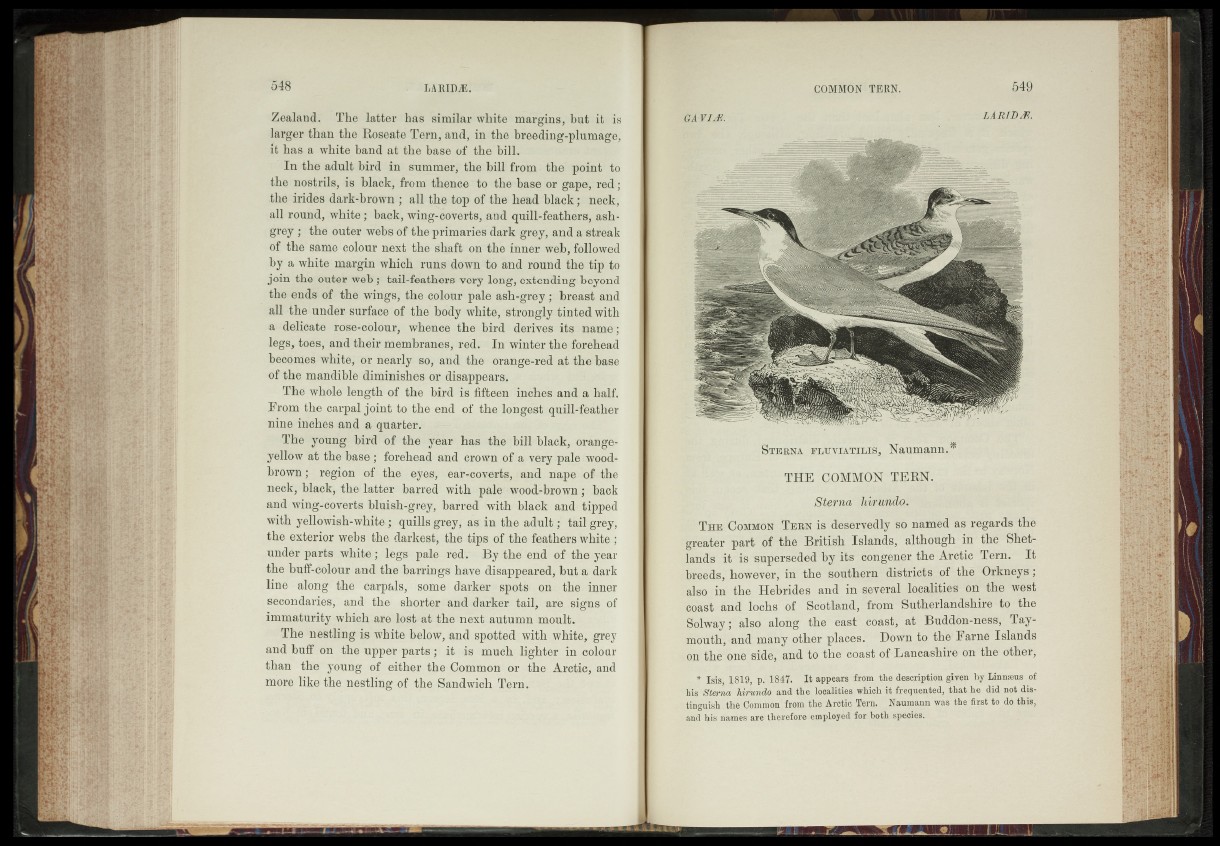
Zealand. The latter has similar white margins, but itrrs
larger than the Roseate Tern, and, in the breeding-plumage,
it has a white band at the base of the bill.
In the adult bird in summer, the bill from the point to
the nostrils, is black, from thence to the base or gape, red ;
the irides dark-brewn ; all the top of the head black; neck,
all round, white; back, wing-coverts, and quill-feathers, ash-
grey ; the outer webs of the primaries dark grey, and a streak
of the same colour next the shaft on the inner web, followed
by a white margin which runs down to and round the tip to
join the outer web; tail-feathers very long, extending beyond
the ends of the wings, the colour pale ash-grey; breast and
all the under surface of the body white, strongly tinted with
a delicate rose-colour, whence the bird derives its name;
legs, toes, and their membranes, red. In winter the forehead
becomes white, or nearly so, and the orange-red at the base
of the mandible diminishes or disappears.
The whole length of the bird is fifteen inches, and. a half.
From the carpal joint to the end the longest quiM-feather
nnm inches and a quarter. .
The young bird: of the year has the ^brH’«bIack, orange-
yellow at the base; forehead and crown of .a very pale wood-
brown ; region of the eyesy ear-coverts, and nape’oibthe
neek, black, the^latter barred with pale wood-brown; back
and wing-eoverts bluish-grey, barred" with black and? tipped
with yellowish-white; quills grey, as in the adult; tail grey,
the exterior webs the darkest, the tips of the feathers white ;
under parts white yslfegS; pale redr By tjbe end ©f th e n a r
the buff-colour and the barrings have disappeared, but a dark
line along the Carpals, some darker spots- on the, ipner
secondaries, and the shorter- and darker-' tail, are signs of
immaturity whieh^are-lest^at the next autumn moult;
The nestling is white below, and spotted with whiter grey
and buff on the upper parts; it -i-s much lighter in colour
than the young of ^ either the Common or the Arctic, and
more like the nestling of the-Sandwich Tern.
GAYIÆ. LARIDÆ.
/•S terna pluviatjlis, Naumann.*
THE TERjSq
Sterna' tj^wii/ùdq:;
' * T h e C ommon T e r n is deservedly so named as regards the
greater part of the Brit%ll Islands, although > in ’ the Shot-
lands' utClis superseded by'its'congener the Arctic Tern. It
breeds,' however, in -tixd southern7 districts/of* the Orkneys ;
also in the Hebrides/and in several -localities on the west
coast and lochs of’ pcotlan’dy from Sutherlandshire * to/the
Solway; also along the east1 coast; at Budden-ness, Tay-
'moiith; -and mank other places. Down to the’Fame Islands
on the4 one, side, and to the boaid? of "Lancashire on the other,
•L,f Isis 4819, ' It appears. Irarn. the description given by Linnæus pf
his Sterna hirundo and the lôqalitips which'it fre/pxenjed, that he djd not dis;
tînguish th e ic ^ S ^A fr0™ th^Arcfhl Tern. Nauma|m wal’the first to dp this,
and his names are therefore-‘employed for .both species.